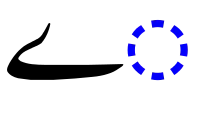Baṛī ye
Baṛī ye (Urdu: بَڑی يے; lit. "greater ye") is a letter in the Urdu alphabet (and other Indo-Iranian language alphabets based on it) directly based on the alternative "returned" variant of the final form of the Arabic letter ye/yāʾ (known as yāʾ mardūda) found in the Hijazi, Kufic, Thuluth, Naskh, and Nastaliq scripts.[1] It functions as the word-final yā-'e-majhūl ([eː]) and yā-'e-sākin ([ɛː]).[2] It is distinguished from the "choṭī ye (چھوٹی يے; "lesser ye")", which is the regular Perso-Arabic yāʾ (ی) used elsewhere. In Punjabi, where it is a part of the Shahmukhi alphabet, it is called waḍḍī ye (Punjabi: وَڈّی یے) with the Gurmukhi equivalent ਏ.
| Baṛī ye بَڑی يے | |
|---|---|
| ے | |
| ۓ | |
 | |
| Usage | |
| Writing system | Arabic abjad Urdu alphabet Shahmukhi (Punjabi) Saraiki alphabet Kashmiri alphabet Burushaski alphabet Khowar alphabet |
| Type | Abjad Alphabetic |
| Language of origin | Urdu |
| Phonetic usage | /eː/ /ɛː/ /eɪ/ |
| Unicode codepoint | U+06D2 |
| Alphabetical position | 38 |
| History | |
| Development | |
| Time period | ~1200 to present |
| Descendants | ◌ެ [lower-alpha 1] |
| Sisters | ی ي ێ ې ۍ ئ ٸ ؠ ؾ ؿ |
| Transliteration equivalents | Ē Ai (digraph) Ei (digraph) |
| Variations | ۓ |
| Other | |
| Writing direction | Right-to-left |
| Urdu alphabet |
|---|
| ا ب پ ت ٹ ث ج چ ح خ د ڈ ذ ر ڑ ز ژ س ش ص ض ط ظ ع غ ف ق ک گ ل م ن (ں) و ہ (ھ) ء ی ے |
|
Extended Perso-Arabic script |
It is also used in the Pakistani Pashto alphabet, with the Afghani equivalent being ی.
Forms
Baṛī ye is written multiple ways depending on its position:
| Position in word: | Isolated | Final | Medial | Initial |
|---|---|---|---|---|
| Naskh glyph form: (Help) |
ے | ـے | ـے | ے |
| Nastaʿlīq glyph form: | ے | ــــے | ــــے | ے |
There are also medial (ـیـ) and initial (یـ) forms, but they are not encoded on Unicode and are generally represented by the regular ye.
Diacritical variants
In Urdu, only the hamza can be applied to baṛī ye:
| Position in word: | Isolated | Final | Medial | Initial |
|---|---|---|---|---|
| Naskh glyph form: (Help) |
ۓ | ـۓ | ـۓ | ۓ |
| Nastaʿlīq glyph form: | ۓ | ــــۓ | ــــۓ | ۓ |
In Kashmiri, there is a letter that is visually a baṛī ye with a small v sign above, known as the nīmü yāyūk:
| Position in word: | Isolated | Final | Medial | Initial |
|---|---|---|---|---|
| Naskh glyph form: (Help) |
ےٚ | ـےٚ | ـےٚـ | ےٚـ |
| Nastaʿlīq glyph form: | ےٚ | ــــےٚ | ــــےٚــــ | ےٚــــ |
Burushaski
In Burushaski, there are 3 baṛī ye's: ے, ݺ, and ݻ.
One of the additional letters is a baṛī ye with the Arabic–Indic digit 2 (۲).
| Position in word: | Isolated | Final | Medial | Initial |
|---|---|---|---|---|
| Naskh glyph form: (Help) |
ݺ | ـݺ | ـݺـ | ݺـ |
| Nastaʿlīq glyph form: | ݺ | ــــݺ | ــــݺــــ | ݺــــ |
It is used to represent the short vowel /e/.
Another letter has a 3 (۳) above it. Unlike ݺ, which represents a shorter sound than the regular baṛī ye, it represents the same long vowel (/eː/) but with primary stress (e.g. /ˈeː/).
| Position in word: | Isolated | Final | Medial | Initial |
|---|---|---|---|---|
| Naskh glyph form: (Help) |
ݻ | ـݻ | ـݻـ | ݻـ |
| Nastaʿlīq glyph form: | ݻ | ــــݻ | ــــݻــــ | ݻــــ |
Character encoding
| Preview | ے | |
|---|---|---|
| Unicode name | ARABIC LETTER YEH BARREE | |
| Encodings | decimal | hex |
| Unicode | 1746 | U+06D2 |
| UTF-8 | 219 146 | DB 92 |
| Numeric character reference | ے | ے |
Notes
- Thaana vowel ebefili; thought to be derived from baṛī ye based on visual and phonetic similarities.
References
- Gacek, Adam (2009). Arabic Manuscripts: A Vademecum for Readers. BRILL. ISBN 978-90-474-4303-2.
- Shakespeare, John (1818). A Grammar of the Hindustani Language. author. Retrieved 25 February 2020.